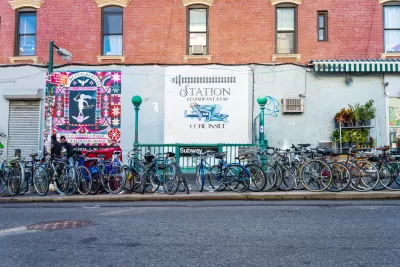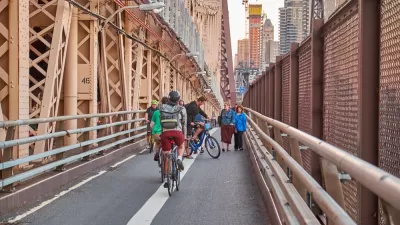Bike rooms for office buildings are hardly new. Now they are making their way into the New York City residential real estate market, big time. These rooms may come with bike repair equipment, and in some cases, the apartments may come with new bikes.

"Driven by demand as well as a city mandate, developers and building owners are carving out bike rooms for residents to store what for some has become their transportation mode of choice," writes Jane Margolies for The New York Times.
The state-of-the-art spaces often have their own entrances, saving wear-and-tear on the lobby and passenger elevators. They also offer their own gear by way of pumps and repair stands, and, sometimes, homey touches like hooks for hanging helmets. In the fancier buildings, porters and door attendants act as bike valets.
Of course, riders can store their bikes in their apartments, if there’s room. But “now when you’re spending a million dollars for a one-bedroom,” said Roberta Axelrod, the director of residential sales and marketing at Time Equities [a real estate agency], “no one wants a bike in there” propped against the wall.
And it's not just new buildings that are seeing the consequences of increased ridership as older buildings are converting underutilized areas into bike rooms. "As for new buildings, a zoning amendment passed in 2009 requires the provision of one bike space for every two units in structures of 10 apartments or more," adds Margolies. However, that's often a bare-bones requirement inadequate for larger units.
If you have a building with two- and three-bedroom apartments, 100 units doesn’t mean 100 bikes,” said Matthew Baron, the president of Simon Baron Development. “It could be 300 or 400.” Consequently, there are waiting lists for many of the city’s bike rooms.
Would you like a bike with that unit?
"Many buildings are providing the bicycles themselves, acquiring their own fleets — emblazoned with the buildings’ names — for residents’ use," writes Margolies. Other buildings are offering bikes as closing gifts. She goes on to list these apartments, in addition to describing bike storage at new and existing apartments in Brooklyn and Manhattan.
Pay-to-Park
But don't expect to park for free; these spaces often come at a cost. "The charges, which can come in the form of a monthly or annual fee, vary widely, from a token $10 per year to $10 to $100 per month," adds Margolies.
FULL STORY: Buildings Get Bike Friendly

Maui's Vacation Rental Debate Turns Ugly
Verbal attacks, misinformation campaigns and fistfights plague a high-stakes debate to convert thousands of vacation rentals into long-term housing.

Planetizen Federal Action Tracker
A weekly monitor of how Trump’s orders and actions are impacting planners and planning in America.

In Urban Planning, AI Prompting Could be the New Design Thinking
Creativity has long been key to great urban design. What if we see AI as our new creative partner?

How Trump's HUD Budget Proposal Would Harm Homelessness Response
Experts say the change to the HUD budget would make it more difficult to identify people who are homeless and connect them with services, and to prevent homelessness.

The Vast Potential of the Right-of-Way
One writer argues that the space between two building faces is the most important element of the built environment.

Florida Seniors Face Rising Homelessness Risk
High housing costs are pushing more seniors, many of them on a fixed income, into homelessness.
Urban Design for Planners 1: Software Tools
This six-course series explores essential urban design concepts using open source software and equips planners with the tools they need to participate fully in the urban design process.
Planning for Universal Design
Learn the tools for implementing Universal Design in planning regulations.
Gallatin County Department of Planning & Community Development
Heyer Gruel & Associates PA
JM Goldson LLC
Mpact (founded as Rail~Volution)
City of Camden Redevelopment Agency
City of Astoria
Jefferson Parish Government
Camden Redevelopment Agency
City of Claremont




























